Image (mathematics)
In mathematics, the image of a function is the set of all output values it may produce.
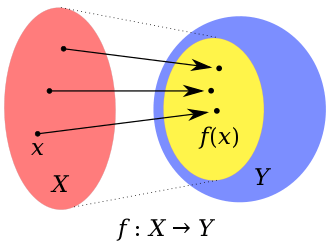
| Algebraic structure → Group theory Group theory | ||||
|---|---|---|---|---|
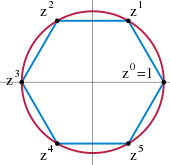 | ||||
|
Basic notions
|
||||
|
||||
|
||||
Infinite dimensional Lie group
|
||||
|
Algebraic groups |
||||
More generally, evaluating a given function f at each element of a given subset A of its domain produces a set called the "image of A under (or through) f ". The inverse image or preimage of a given subset B of the codomain of f is the set of all elements of the domain that map to the members of B.
Image and inverse image may also be defined for general binary relations, not just functions.
Definition
The word "image" is used in three related ways. In these definitions, f : X → Y is a function from the set X to the set Y.
Image of an element
If x is a member of X, then f(x) = y (the value of f when applied to x) is the image of x under f. y is alternatively known as the output of f for argument x.
Image of a subset
The image of a subset A ⊆ X under f is the subset f[A] ⊆ Y defined by (using set-builder notation):
When there is no risk of confusion, f[A] is simply written as f(A). This convention is a common one; the intended meaning must be inferred from the context. This makes f[.] a function whose domain is the power set of X (the set of all subsets of X), and whose codomain is the power set of Y. See Notation below.
Image of a function
The image of a function is the image of its entire domain.
Generalization to binary relations
If R is an arbitrary binary relation on X×Y, the set { y∈Y | xRy for some x∈X } is called the image, or the range, of R. Dually, the set { x∈X | xRy for some y∈Y } is called the domain of R.
Inverse image
Let f be a function from X to Y. The preimage or inverse image of a set B ⊆ Y under f is the subset of X defined by
The inverse image of a singleton, denoted by f −1[{y}] or by f −1[y], is also called the fiber over y or the level set of y. The set of all the fibers over the elements of Y is a family of sets indexed by Y.
For example, for the function f(x) = x2, the inverse image of {4} would be {−2, 2}. Again, if there is no risk of confusion, denote f −1[B] by f −1(B), and think of f −1 as a function from the power set of Y to the power set of X. The notation f −1 should not be confused with that for inverse function. The notation coincides with the usual one, though, for bijections, in the sense that the inverse image of B under f is the image of B under f −1.
Notation for image and inverse image
The traditional notations used in the previous section can be confusing. An alternative[1] is to give explicit names for the image and preimage as functions between powersets:
Arrow notation
- with
- with
Star notation
- instead of
- instead of
Other terminology
- An alternative notation for f[A] used in mathematical logic and set theory is f "A.[2][3]
- Some texts refer to the image of f as the range of f, but this usage should be avoided because the word "range" is also commonly used to mean the codomain of f.
Examples
- f: {1, 2, 3} → {a, b, c, d} defined by The image of the set {2, 3} under f is f({2, 3}) = {a, c}. The image of the function f is {a, c}. The preimage of a is f −1({a}) = {1, 2}. The preimage of {a, b} is also {1, 2}. The preimage of {b, d} is the empty set {}.
- f: R → R defined by f(x) = x2. The image of {−2, 3} under f is f({−2, 3}) = {4, 9}, and the image of f is R+. The preimage of {4, 9} under f is f −1({4, 9}) = {−3, −2, 2, 3}. The preimage of set N = {n ∈ R | n < 0} under f is the empty set, because the negative numbers do not have square roots in the set of reals.
- f: R2 → R defined by f(x, y) = x2 + y2. The fibres f −1({a}) are concentric circles about the origin, the origin itself, and the empty set, depending on whether a > 0, a = 0, or a < 0, respectively.
- If M is a manifold and π: TM → M is the canonical projection from the tangent bundle TM to M, then the fibres of π are the tangent spaces Tx(M) for x∈M. This is also an example of a fiber bundle.
- A quotient group is a homomorphic image.
Properties
| Counter-examples based on f:ℝ→ℝ, x↦x2, showing that equality generally need not hold for some laws: |
|---|
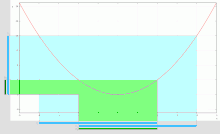 f(A1∩A2) ⊊ f(A1) ∩ f(A2) |
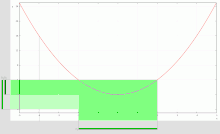 f(f−1(B3)) ⊊ B3 |
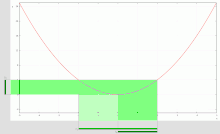 f−1(f(A4)) ⊋ A4 |
For every function f : X → Y, all subsets A, A1, and A2 of X and all subsets B, B1, and B2 of Y, the following properties hold:
- f(A1 ∪ A2) = f(A1) ∪ f(A2)[4]
- f(A1 ∩ A2) ⊆ f(A1) ∩ f(A2)[4]
- f(A ∩ f −1(B)) = f(A) ∩ B
- f −1(B1 ∪ B2) = f −1(B1) ∪ f −1(B2)
- f −1(B1 ∩ B2) = f −1(B1) ∩ f −1(B2)
- f(A) = ∅ ⇔ A = ∅
- f −1(B) = ∅ ⇔ B ⊆ (f(X))C
- f(A) ∩ B = ∅ ⇔ A ∩ f −1(B) = ∅
- f(A) ⊆ B ⇔ A ⊆ f −1(B)
- B ⊆ f(A) ⇔ C ⊆ A (f(C) = B)
- f(f −1(B)) ⊆ B[5]
- f −1(f(A)) ⊇ A[6]
- f(f −1(B)) = B ∩ f(X)
- f −1(f(X)) = X
- A1 ⊆ A2 ⇒ f(A1) ⊆ f(A2)
- B1 ⊆ B2 ⇒ f −1(B1) ⊆ f −1(B2)
- f −1(BC) = (f −1(B))C
- (f |A)−1(B) = A ∩ f −1(B).
The results relating images and preimages to the (Boolean) algebra of intersection and union work for any collection of subsets, not just for pairs of subsets:
(Here, S can be infinite, even uncountably infinite.)
With respect to the algebra of subsets, by the above the inverse image function is a lattice homomorphism while the image function is only a semilattice homomorphism (it does not always preserve intersections).
See also
- Range of a function
- Bijection, injection and surjection
- Kernel of a function
- Image (category theory)
- Set inversion
Notes
- Blyth 2005, p. 5
- Jean E. Rubin (1967). Set Theory for the Mathematician. Holden-Day. p. xix. ASIN B0006BQH7S.
- M. Randall Holmes: Inhomogeneity of the urelements in the usual models of NFU, December 29, 2005, on: Semantic Scholar, p. 2
- Kelley (1985), p. 85
- Equality holds if B is a subset of f(X) or, in particular, if f is surjective. See Munkres, J.. Topology (2000), p. 19.
- Equality holds if f is injective. See Munkres, J.. Topology (2000), p. 19.
References
- Artin, Michael (1991). Algebra. Prentice Hall. ISBN 81-203-0871-9.
- T.S. Blyth, Lattices and Ordered Algebraic Structures, Springer, 2005, ISBN 1-85233-905-5.
- Munkres, James R. (2000). Topology (2 ed.). Prentice Hall. ISBN 978-0-13-181629-9.
- Kelley, John L. (1985). General Topology. Graduate Texts in Mathematics. 27 (2 ed.). Birkhäuser. ISBN 978-0-387-90125-1.
This article incorporates material from Fibre on PlanetMath, which is licensed under the Creative Commons Attribution/Share-Alike License.